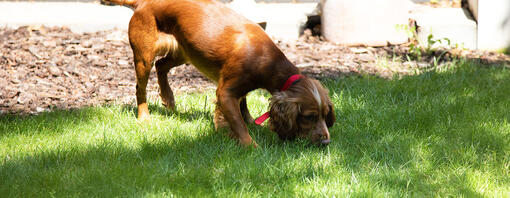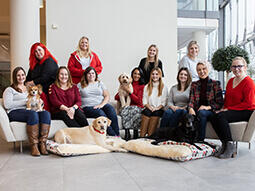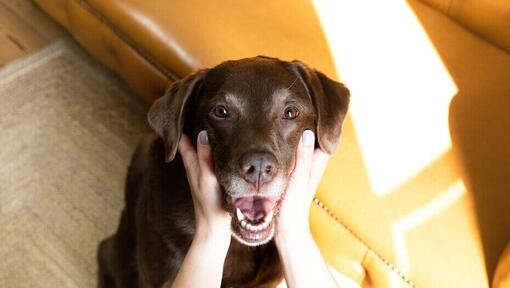
Even if your dog is blind, nothing can dampen their adventurous, fun-loving spirit! Dogs cope well with the loss of their sight, and all it takes is certain changes to the way they are looked after to get them back on their paws. In fact, if allowances are made for the loss of their eyesight, your dog’s life should be every inch as good as it was before.
What are the causes of blindness in dogs?
Blindness in dogs can develop for many reasons; there’s no need to blame yourself or wonder what went wrong. Blindness may:
- Be present from birth.
- Be acquired later in life as the result of a traumatic injury or disease.
Simply be related to the ageing of your dog’s senses. Some inherited causes of blindness can be tested for in the parents of your dog, or in young puppies before you take them home. Inherited causes tend to be seen in certain breeds – for example, blindness is more common in Collies due to a condition called ‘Collie eye anomaly’. When considering buying a purebred puppy, speak to your vet about the potential problems certain breeds can inherit. This way, you should know more about your chances of eventually caring for a blind dog, and decide if you are ready to take the risk.
If you suspect your dog is losing their vision at any time, consult your vet. Some conditions causing such signs of blindness are very treatable – for example, cataracts can be removed. This is why it’s always good to check, even if your dog seems to be doing very well without their eyesight.
Is my dog blind?
If your dog is blind, there are a few things you might notice about your dog’s behaviour:
- Most obviously, dogs that bump into things may be losing their sight.
- If your dog is blind in one eye, they may be startled by sudden movements on their blind side – they won’t have seen you or something else coming.
- Dogs that go suddenly blind may be disorientated and distressed.
- You may notice an abnormality when looking at the eyes of your dog – perhaps something that doesn’t look like it used to. You know them best!
- Your dog might not follow your hand or a treat when it’s moved, even though their energy and tail-wagging enthusiasm is just as high as it should be.
If you are concerned about your dog's eyesight, arrange for an examination by your vet as some conditions can be effectively treated, preventing further vision loss. However, sudden blindness in dogs is a veterinary emergency, and may cause your pet to become disorientated or distressed – in these cases, you should act quickly.
How will blindness affect my dog?
Surprisingly, blindness in dogs presents few problems to the average household canine. In fact, you could easily and understandably be unaware of your dog's loss of sight until you move to a new environment or modify your existing one.
If your dog’s loss of vision happens on a gradual basis, as it would with senile cataracts or progressive genetic conditions, they will learn to find their way around furniture, food bowls and stairwells as if their vision is perfect. Rather than trying to fool you, they’re just learning to cope without a fuss – and doing it very well.
Your dog’s poor vision isn't necessarily that much of an obstacle once you both go outside, either. An elderly Border Collie for example, blind since the age of seven years, could be the best dog in the world at a game of fetch. And even long walks on the lead can be enjoyable if the ground surface is relatively even and you’re taking a familiar route. If your dog has been blind since they were a puppy, you may want to consult a dog trainer for advice on training blind dogs. There are special techniques for training non-visual dogs that can really help you and your canine friend get the most out of each other’s skills.
Helping blind dogs adapt:
- As far as you can, don't leave obstacles in unexpected places and avoid moving furniture around as this could cause confusion for your dog with bad eyesight.
- Make sure children understand your dog’s needs, and make sure they don’t leave toys out in case your blind dog trips over them.
- We all talk to our dogs and routinely use verbal cues, so make the most of this: just make speech more frequent and exaggerated to help your blind dog understand you.
- Training is important as a blind dog needs to respond solely to auditory cues. Find a trainer who specialises in training dogs with visual problems.
- Your dog’s sense of smell, meanwhile, can be very useful for them recognising ‘hazardous’ areas. You can 'tag' specific areas of the home so they know what’s coming.
- For example, obstacles such as stair landings could be identified with small amounts of lemon oil – it’s not too smelly for you, but your dog’s sharp nose will soon learn what it means!
- Teach family members to approach your dog cautiously, always using their name as they approach, as it is easy to frighten a blind dog by suddenly touching them.
All in all, no matter the visual abilities of your dog, there’s no reason why full or partial blindness should lower their quality of life. All they need is your love and attention, and you’ll both continue to enjoy life, and each other’s company, as much as ever.
Next, discover how to better understand your dog's body language with our easy-to-follow guide.













